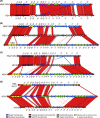Discrimination of major capsular types of Campylobacter jejuni by multiplex PCR
- PMID: 21411576
- PMCID: PMC3122684
- DOI: 10.1128/JCM.02348-10
Discrimination of major capsular types of Campylobacter jejuni by multiplex PCR
Abstract
The polysaccharide capsule (CPS) of Campylobacter jejuni is the major serodeterminant of the Penner serotyping scheme. There are 47 Penner serotypes of C. jejuni, 22 of which fall into complexes of related serotypes. A multiplex PCR method for determination of capsule types of Campylobacter jejuni which is simpler and more affordable than classical Penner typing was developed. Primers specific for each capsule type were designed on the basis of a database of gene sequences from the variable capsule loci of 8 strains of major serotypes sequenced in this study and 10 published sequences of other serotypes. DNA sequence analysis revealed a mosaic nature of the capsule loci, suggesting reassortment of genes by horizontal transfer, and demonstrated a high degree of conservation of genes within Penner complexes. The multiplex PCR can distinguish 17 individual serotypes in two PCRs with sensitivities and specificities ranging from 90 to 100% using 244 strains of known Penner type.
Figures



Similar articles
-
Genetic Characteristics and Multiple-PCR Development for Capsular Identification of Specific Serotypes of Campylobacter jejuni.PLoS One. 2016 Oct 27;11(10):e0165159. doi: 10.1371/journal.pone.0165159. eCollection 2016. PLoS One. 2016. PMID: 27788180 Free PMC article.
-
Updated Campylobacter jejuni Capsule PCR Multiplex Typing System and Its Application to Clinical Isolates from South and Southeast Asia.PLoS One. 2015 Dec 2;10(12):e0144349. doi: 10.1371/journal.pone.0144349. eCollection 2015. PLoS One. 2015. PMID: 26630669 Free PMC article.
-
Analysis of Campylobacter jejuni capsular loci reveals multiple mechanisms for the generation of structural diversity and the ability to form complex heptoses.Mol Microbiol. 2005 Jan;55(1):90-103. doi: 10.1111/j.1365-2958.2004.04374.x. Mol Microbiol. 2005. PMID: 15612919
-
Campylobacter polysaccharide capsules: virulence and vaccines.Front Cell Infect Microbiol. 2012 Feb 15;2:7. doi: 10.3389/fcimb.2012.00007. eCollection 2012. Front Cell Infect Microbiol. 2012. PMID: 22919599 Free PMC article. Review.
-
A systematic review and meta-analysis of Penner serotype prevalence of Campylobacter jejuni in low- and middle-income countries.PLoS One. 2021 May 5;16(5):e0251039. doi: 10.1371/journal.pone.0251039. eCollection 2021. PLoS One. 2021. PMID: 33951106 Free PMC article.
Cited by
-
Key Role of Capsular Polysaccharide in the Induction of Systemic Infection and Abortion by Hypervirulent Campylobacter jejuni.Infect Immun. 2017 May 23;85(6):e00001-17. doi: 10.1128/IAI.00001-17. Print 2017 Jun. Infect Immun. 2017. PMID: 28373351 Free PMC article.
-
Development of a Multiplex PCR Assay for Rapid Molecular Serotyping of Haemophilus parasuis.J Clin Microbiol. 2015 Dec;53(12):3812-21. doi: 10.1128/JCM.01991-15. Epub 2015 Sep 30. J Clin Microbiol. 2015. PMID: 26424843 Free PMC article.
-
Zoonotic Transmission of Campylobacter jejuni to Caretakers From Sick Pen Calves Carrying a Mixed Population of Strains With and Without Guillain Barré Syndrome-Associated Lipooligosaccharide Loci.Front Microbiol. 2022 Apr 29;13:800269. doi: 10.3389/fmicb.2022.800269. eCollection 2022. Front Microbiol. 2022. PMID: 35591997 Free PMC article.
-
Determination of azithromycin heteroresistant Campylobacter jejuni in traveler's diarrhea.Gut Pathog. 2019 May 6;11:19. doi: 10.1186/s13099-019-0301-1. eCollection 2019. Gut Pathog. 2019. PMID: 31080519 Free PMC article.
-
Distribution of genes related to Type 6 secretion system and lipooligosaccharide that induced ganglioside mimicry among Campylobacter jejuni isolated from human diarrhea in Thailand.Gut Pathog. 2020 Apr 9;12:18. doi: 10.1186/s13099-020-00357-6. eCollection 2020. Gut Pathog. 2020. PMID: 32308743 Free PMC article.
References
-
- Allos B. M. 2001. Campylobacter jejuni infections: update on emerging issues and trends. Clin. Infect. Dis. 32:1201–1206 - PubMed
-
- Ang C. W., Jacobs B. C., Laman J. D. 2004. The Guillain-Barre syndrome: a true case of molecular mimicry. Trends Immunol. 25:61–66 - PubMed
-
- Aspinall G. O., Lynch C. M., Pang H., Shaver R. T., Moran A. P. 1995. Chemical structures of the core region of Campylobacter jejuni O:3 lipopolysaccharide and an associated polysaccharide. Eur. J. Biochem. 231:570–578 - PubMed
-
- Aspinall G. O., McDonald A. G., Pang H. 1992. Structures of the O chains from lipopolysaccharides of Campylobacter jejuni serotypes O:23 and O:36. Carbohydr. Res. 231:13–30 - PubMed
-
- Bachtiar B. M., Coloe P. J., Fry B. N. 2007. Knockout mutagenesis of the kpsE gene of Campylobacter jejuni 81116 and its involvement in bacterium-host interactions. FEMS Immunol. Med. Microbiol. 49:149–154 - PubMed
Publication types
MeSH terms
Substances
Associated data
- Actions
- Actions
- Actions
- Actions
- Actions
- Actions
- Actions
- Actions
LinkOut - more resources
Full Text Sources
Other Literature Sources
Molecular Biology Databases

